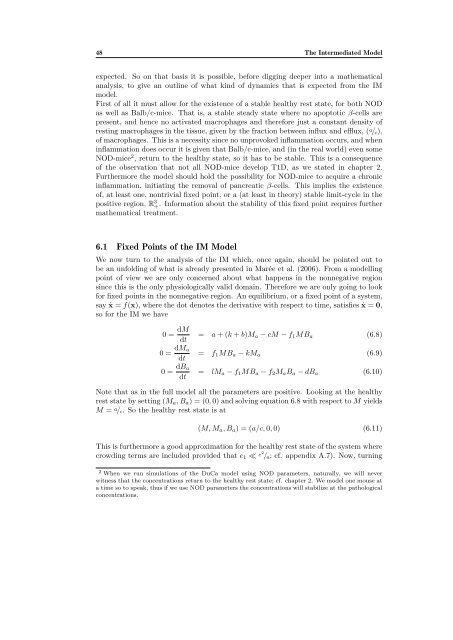nr. 477 - 2011 - Institut for Natur, Systemer og Modeller (NSM)
nr. 477 - 2011 - Institut for Natur, Systemer og Modeller (NSM)
nr. 477 - 2011 - Institut for Natur, Systemer og Modeller (NSM)
Create successful ePaper yourself
Turn your PDF publications into a flip-book with our unique Google optimized e-Paper software.
48 The Intermediated Model<br />
expected. So on that basis it is possible, be<strong>for</strong>e digging deeper into a mathematical<br />
analysis, to give an outline of what kind of dynamics that is expected from the IM<br />
model.<br />
First of all it must allow <strong>for</strong> the existence of a stable healthy rest state, <strong>for</strong> both NOD<br />
as well as Balb/c-mice. That is, a stable steady state where no apoptotic β-cells are<br />
present, and hence no activated macrophages and there<strong>for</strong>e just a constant density of<br />
resting macrophages in the tissue, given by the fraction between influx and efflux, ( a/c),<br />
of macrophages. This is a necessity since no unprovoked inflammation occurs, and when<br />
inflammation does occur it is given that Balb/c-mice, and (in the real world) even some<br />
NOD-mice 2 , return to the healthy state, so it has to be stable. This is a consequence<br />
of the observation that not all NOD-mice develop T1D, as we stated in chapter 2.<br />
Furthermore the model should hold the possibility <strong>for</strong> NOD-mice to acquire a chronic<br />
inflammation, initiating the removal of pancreatic β-cells. This implies the existence<br />
of, at least one, nontrivial fixed point, or a (at least in theory) stable limit-cycle in the<br />
positive region, R 3 +. In<strong>for</strong>mation about the stability of this fixed point requires further<br />
mathematical treatment.<br />
6.1 Fixed Points of the IM Model<br />
We now turn to the analysis of the IM which, once again, should be pointed out to<br />
be an unfolding of what is already presented in Marée et al. (2006). From a modelling<br />
point of view we are only concerned about what happens in the nonnegative region<br />
since this is the only physiol<strong>og</strong>ically valid domain. There<strong>for</strong>e we are only going to look<br />
<strong>for</strong> fixed points in the nonnegative region. An equilibrium, or a fixed point of a system,<br />
say ˙x = f(x), where the dot denotes the derivative with respect to time, satisfies ˙x = 0,<br />
so <strong>for</strong> the IM we have<br />
0 = dM<br />
dt = a + (k + b)Ma − cM − f1MBa (6.8)<br />
0 = dMa<br />
dt<br />
0 = dBa<br />
dt<br />
= f1MBa − kMa (6.9)<br />
= lMa − f1MBa − f2MaBa − dBa (6.10)<br />
Note that as in the full model all the parameters are positive. Looking at the healthy<br />
rest state by setting (Ma, Ba) = (0, 0) and solving equation 6.8 with respect to M yields<br />
M = a/c. So the healthy rest state is at<br />
(M, Ma, Ba) = (a/c, 0, 0) (6.11)<br />
This is furthermore a good approximation <strong>for</strong> the healthy rest state of the system where<br />
crowding terms are included provided that e1 ≪ c2<br />
/a; cf. appendix A.7). Now, turning<br />
2 When we run simulations of the DuCa model using NOD parameters, naturally, we will never<br />
witness that the concentrations return to the healthy rest state; cf. chapter 2. We model one mouse at<br />
a time so to speak, thus if we use NOD parameters the concentrations will stabilize at the pathol<strong>og</strong>ical<br />
concentrations.
















